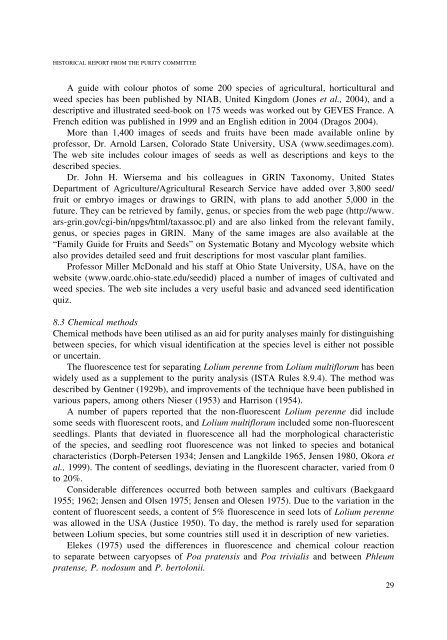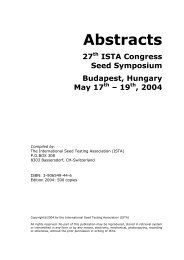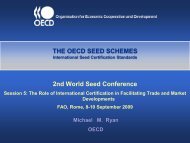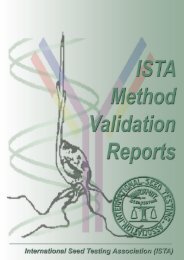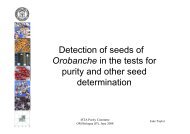Historical Paper - Volume 2 2008 - International Seed Testing ...
Historical Paper - Volume 2 2008 - International Seed Testing ...
Historical Paper - Volume 2 2008 - International Seed Testing ...
You also want an ePaper? Increase the reach of your titles
YUMPU automatically turns print PDFs into web optimized ePapers that Google loves.
HISTORICAL REPORT FROM THE PURITY COMMITTEE<br />
A guide with colour photos of some 200 species of agricultural, horticultural and<br />
weed species has been published by NIAB, United Kingdom (Jones et al., 2004), and a<br />
descriptive and illustrated seed-book on 175 weeds was worked out by GEVES France. A<br />
French edition was published in 1999 and an English edition in 2004 (Dragos 2004).<br />
More than 1,400 images of seeds and fruits have been made available online by<br />
professor, Dr. Arnold Larsen, Colorado State University, USA (www.seedimages.com).<br />
The web site includes colour images of seeds as well as descriptions and keys to the<br />
described species.<br />
Dr. John H. Wiersema and his colleagues in GRIN Taxonomy, United States<br />
Department of Agriculture/Agricultural Research Service have added over 3,800 seed/<br />
fruit or embryo images or drawings to GRIN, with plans to add another 5,000 in the<br />
future. They can be retrieved by family, genus, or species from the web page (http://www.<br />
ars-grin.gov/cgi-bin/npgs/html/taxassoc.pl) and are also linked from the relevant family,<br />
genus, or species pages in GRIN. Many of the same images are also available at the<br />
“Family Guide for Fruits and <strong>Seed</strong>s” on Systematic Botany and Mycology website which<br />
also provides detailed seed and fruit descriptions for most vascular plant families.<br />
Professor Miller McDonald and his staff at Ohio State University, USA, have on the<br />
website (www.oardc.ohio-state.edu/seedid) placed a number of images of cultivated and<br />
weed species. The web site includes a very useful basic and advanced seed identification<br />
quiz.<br />
8.3 Chemical methods<br />
Chemical methods have been utilised as an aid for purity analyses mainly for distinguishing<br />
between species, for which visual identification at the species level is either not possible<br />
or uncertain.<br />
The fluorescence test for separating Lolium perenne from Lolium multiflorum has been<br />
widely used as a supplement to the purity analysis (ISTA Rules 8.9.4). The method was<br />
described by Gentner (1929b), and improvements of the technique have been published in<br />
various papers, among others Nieser (1953) and Harrison (1954).<br />
A number of papers reported that the non-fluorescent Lolium perenne did include<br />
some seeds with fluorescent roots, and Lolium multiflorum included some non-fluorescent<br />
seedlings. Plants that deviated in fluorescence all had the morphological characteristic<br />
of the species, and seedling root fluorescence was not linked to species and botanical<br />
characteristics (Dorph-Petersen 1934; Jensen and Langkilde 1965, Jensen 1980, Okora et<br />
al., 1999). The content of seedlings, deviating in the fluorescent character, varied from 0<br />
to 20%.<br />
Considerable differences occurred both between samples and cultivars (Baekgaard<br />
1955; 1962; Jensen and Olsen 1975; Jensen and Olesen 1975). Due to the variation in the<br />
content of fluorescent seeds, a content of 5% fluorescence in seed lots of Lolium perenne<br />
was allowed in the USA (Justice 1950). To day, the method is rarely used for separation<br />
between Lolium species, but some countries still used it in description of new varieties.<br />
Elekes (1975) used the differences in fluorescence and chemical colour reaction<br />
to separate between caryopses of Poa pratensis and Poa trivialis and between Phleum<br />
pratense, P. nodosum and P. bertolonii.<br />
29


